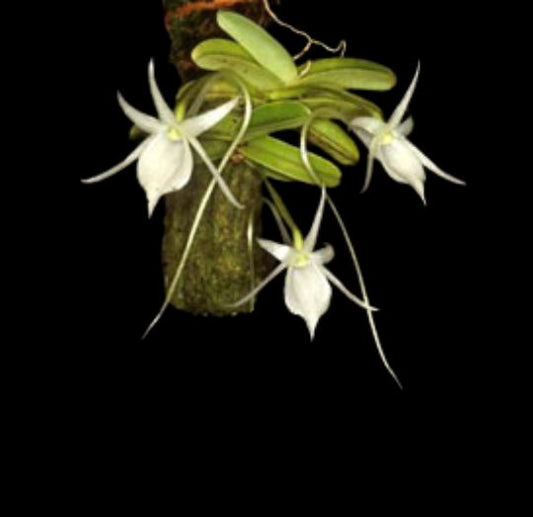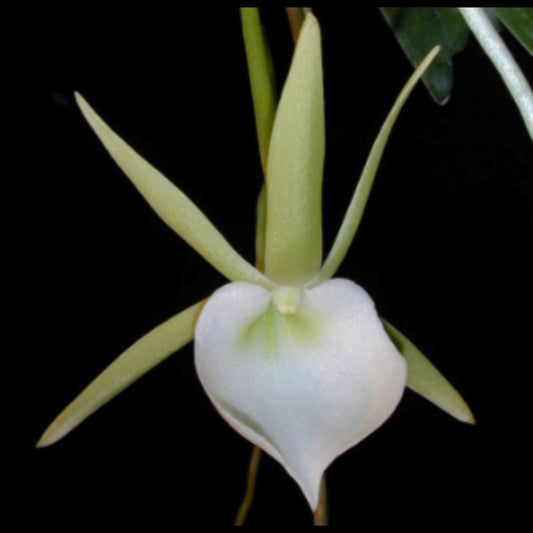La Foresta Orchids
Trichopillia laxa
Trichopillia laxa
No se pudo cargar la disponibilidad de retiro
Trichopilia laxa
Found as an average growth epiphyte, fresh in Venezuela, Colombia, Ecuador and Peru in tropical forests at altitudes of 1200 to 2200 meters.
Found as a medium sized, cool to intermediate growing epiphyte in Venezuela, Colombia, Ecuador and Peru in rainforests at elevations of 1200 to 2200 meters with approximate, linear, ancipitous, compressed pseudobulbs enveloped basally by several, imbricate, papery, maculate sheaths and carrying a single, apical, elliptic-lanceolate to lanceolate, acute or acuminate, coriaceous, conduplicate basally into the short petiole that blooms on a basal, pendant, few [4 to 7] flowered, to 10 2/5" [26 cm] long, terete, pale pinky green, racemose inflorescence with green spotted, maroon bracts and fragrant, waxy flowers occurring in the fall and early winter.
Trichopilia orchid needs a light level of 12000-25000 lux. The light should be filtered or dispersed, and the plants should never be exposed to direct sunlight. Strong air movement should be ensured all the time, especially in the case of the plants grown in lighter conditions, because their quite thick leaves are susceptible to burns.
Temperature:
The average temperature of the day in summer is 23-25 °C, night 13-15 °C, and the amplitude of daily fluctuations is 9-11 °C. The average winter temperature is 22-25 °C during the day and 11-13 °C at night, giving a daily difference of 11-14 °C.
Humidity:
The plants needs the humidity of 80-90% for most of the year, with a fall to 65-70% in late winter. Too dry air has a negative effect on the development of the plant: its growth is inhibited, and the leaves begin to turn yellow and dry out. The higher temperature, the higher the humidity should be, and the higher the humidity, the more often and longer it is necessary to ventilate the room where the plants are contained, otherwise the probability of rotting and various kinds of fungal diseases. Good air movement is essential while the plants are in leaf and growing. You can use a shallow tray of pebbles filled with water to increase humidity around your plants. Be sure the pot does not sit in water as this will rot the roots. Misting can also help in increasing humidity for limited period, but it causes leaf spot diseases if there is not good air circulation.
Substrate, growing media:
Trichopilia orchid grows well attached to pieces of tree ferns or cork, with high humidity ensured and daily watering during the summer. During the dry and hot periods it may be necessary to water several times a day.
They can also grow in pots with a loose substrate, quickly draining excess water, which, however, contains substances that retain a certain amount, such as cut sphagnum moss or perlite. Wood charcoal is also often added to ensure the air permeability of the substrate and protection against acidification.
Repotting:
The plants should be replanted before the substrate begins to be less permeable. The most appropriate time of the year for repotting is the end of winter preceding flowering, as flowers and new growths appear almost at the same time. Therefore, the plants should be repotted when new roots start growing or only a little earlier. This allows the plants to acclimatize in a relatively short time and provides them with the least stress. This is very important, because the plants must acclimate to the additional stress caused by the approaching hot, dry, summer weather.
Watering:
The plants should be watered frequently during active growth, but there should be excellent drainage and the roots need to dry a bit between waterings. The substrate around the roots must never be stale or soggy. When new growths reach maturity in late autumn, the amount of water should be gradually reduced.
Fertilizer:
During the active growth, the plant should be fertilized every week 1/4-1/2 of the recommended dose of fertilizer for orchids. At the beginning of the year, when new growths appear and intensively develop, you can use a fertilizer with an increased nitrogen content, then in late summer and autumn the plants should be fed a fertilizer with an increased content of phosphorus in order to initiate flowering and facilitate the maturation of young growth.
Rest period:
Trichopilia orchid do not need a rest period but can grow and bloom better if they are given a cool and dry dormant period for several weeks. In winter, for 1-2 months, the plants need less water when not actively grown, especially when grown in low light during the short mid-latitude days. They should dry somewhat between waterings, but should not be dry for a longer period. The plant should be supplied with the amount of water that will prevent the pseudobulbs from wrinkling. Fertilization should be limited or should be completely abandoned until new growths appear.
Blooming size in a 4” pot newly repotted
































